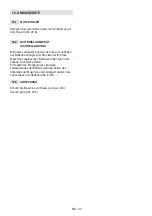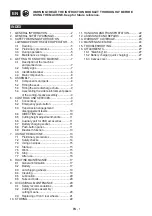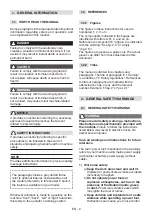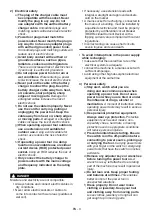
EN - 4
g)
If any devices are to be connected to
dust extractor and collection units,
check they are connected and used
appropriately.
The use of these devices
may reduce dust related risks.
h)
Don't let any familiarity acquired
from use of the machine lead to a
complacent attitude and ignore the
safety principles of the power tool.
Negligent behaviour can cause serious
injuries in a split second.
4) Power tool use and care
a)
Do not force the power tool. Use the
correct power tool for your application.
The correct power tool will do the job
better and safer at the rate for which it was
designed.
b)
Do not use the power tool if the switch
does not turn it on and off.
Any power
tool that cannot be controlled with the
switch is dangerous and must be repaired.
c)
Do not use the machine if the key
switch is not able to start it or stop
it regularly.
A machine that cannot be
operated by the key switch is dangerous
and must be repaired at a service centre.
d)
Remove the ignition key before
carrying out any adjustments, change
of attachments or storing the machine.
Such preventive safety measures
reduce the risk of starting the power tool
accidentally.
e)
Store idle power tools out of the reach
of children and do not allow persons
unfamiliar with the power tool or
these instructions to operate the tool.
Power tools are dangerous in the hands of
untrained users.
f)
Maintenance of the power tools and
attachments. Check for misalignment
or obstruction of moving parts,
breakage of parts and any other
condition that may affect the power
tool’s operation. If damaged, have the
power tool repaired before use.
Many
accidents are caused by poorly maintained
power tools.
g)
Keep cutting tools sharp and clean.
Properly maintained cutting tools with
sharp cutting edges are less likely to
become jammed and are easier to control.
h)
Use the power tool and accessories
in accordance with these instructions,
taking into account the working
conditions and the job to be performed.
Using the power tool for operations
other than those intended could cause
hazardous situations.
i)
Keep hand grips and all holding
surfaces dry, clean and free from oil
and grease residues.
Slippery hand
grips and holding surfaces do not allow
safe handling and control of the tool in
unforeseen situations.
5) Use and precautions to take during use
of battery-operated power tools
a)
Only use battery chargers
recommended by the manufacturer to
recharge batteries.
A battery charger
suitable for one type of battery pack
can pose a risk of fire, electric shock,
overheating or leakage of corrosive battery
fluid if used with a different battery pack.
b)
Use only batteries specifically
designed for your power tool.
Use of
other battery packs may create a risk of
injury or fire
c)
When the battery pack is not in use,
keep it away from other metal objects
such as clips, coins, keys, nails, screws
or other small metal objects, that could
cause a short circuit.
Short circuits
between battery contacts can lead to
explosion or fires.
d)
Batteries in poor condition can cause
liquids to leak. Avoid contact with the
liquid. In the case of accidental contact
flush with water. If the liquid comes
into contact with the eyes, also seek
medical advice.
Liquid leaking from the
battery may cause skin irritation or burns.
e)
Do not use a damaged or modified
battery or tool.
Damaged or modified
batteries may behave unpredictably and
cause fire, explosions or risks of injury.
f)
Do not expose the battery pack or
power tool to fire or excessively high
temperatures.
Exposure to fire or a
temperature exceeding 130 °C may cause
an explosion.
g)
Follow all charging instructions and do
not recharge the battery pack or power
tool outside the temperature range
specified in the instructions.
Improper
charging or charging at temperatures
outside the specified range can damage
the battery and increase the risk of fire.
h)
Do not recharge the battery pack
in places with vapours, flammable
substances or in excessively damp
rooms. If it is not possible to avoid
a humid environment, use a power
outlet protected by a differential circuit
breaker (RCD-Residual Current Device)
to reduce the risk of electric shock.
Summary of Contents for AM 108 Li 48 V2
Page 3: ... Ah battery capacity Nominal voltage min s n kg Type Art N V 9 5 10 1 11 2 8 3 6 12 4 7 1 2 3 ...
Page 4: ...B 2 A C B 2 A D C B D 1 E D E 1 A B B 1 B B 4 5 6 7 ...
Page 5: ... 8 9 I II ...
Page 6: ...10 12 14 16 max 15 27 1 3 11 13 15 ...
Page 7: ... D C B A TEST BEFORE USE TEST RESET 17 18 19 20 21 A H H 30 mm H 10 mm H 20 mm H 0 mm ...
Page 8: ... 22 23 24 25 A B 26 ...
Page 9: ... 27 28 29 ...
Page 414: ......
















































